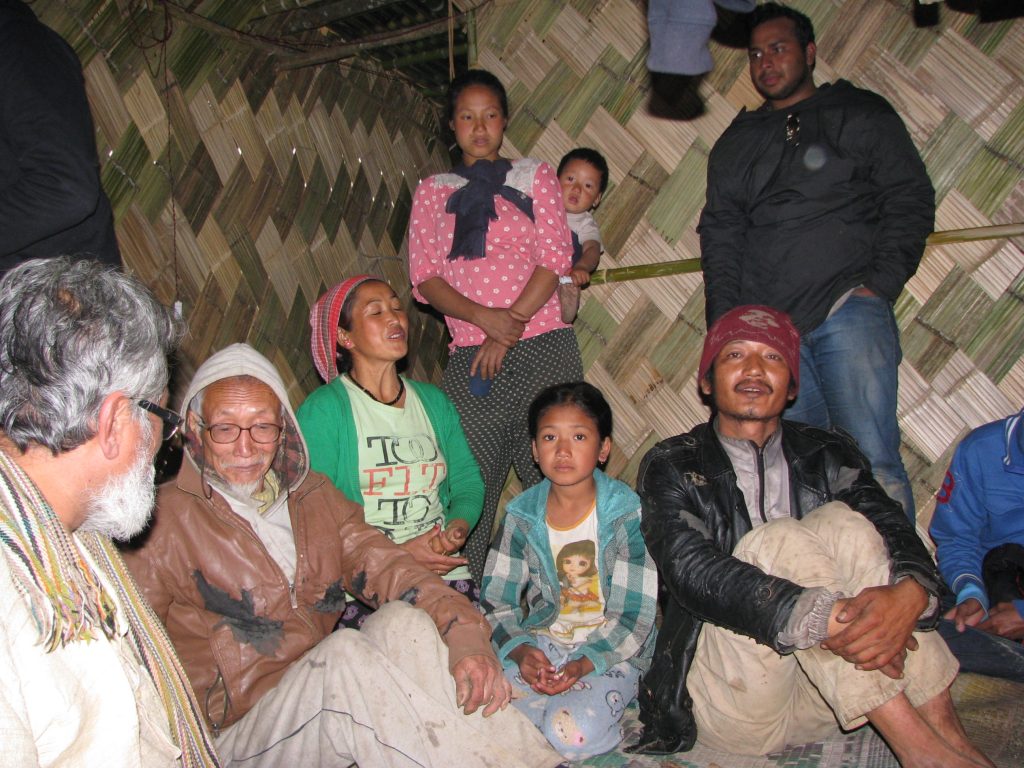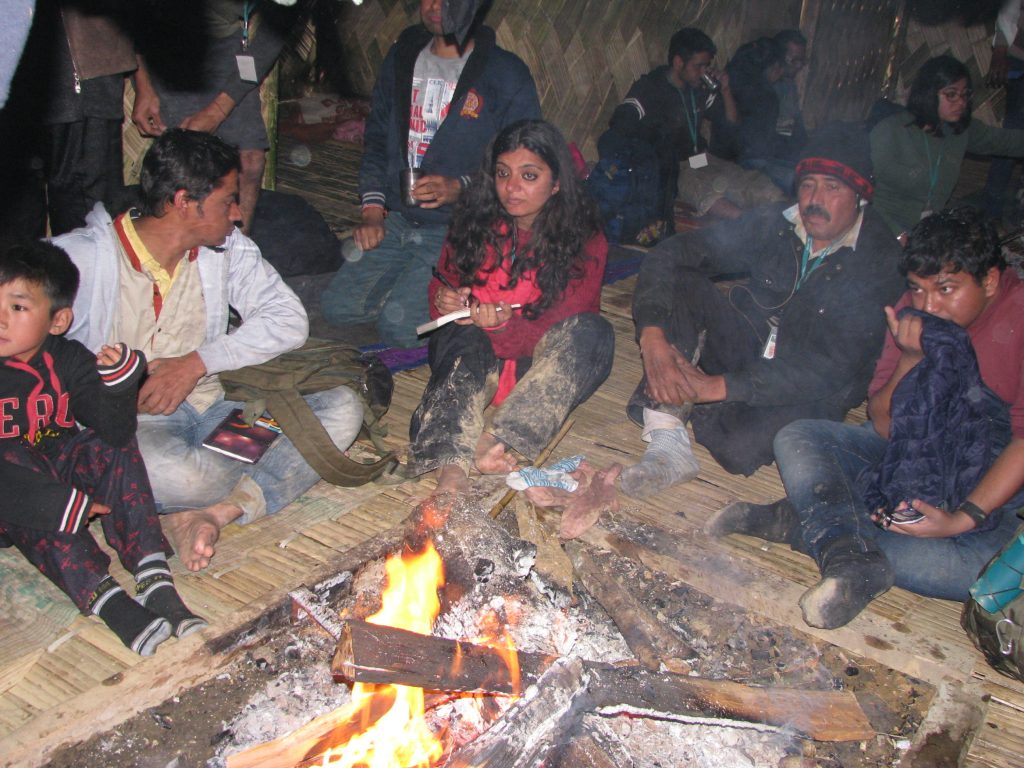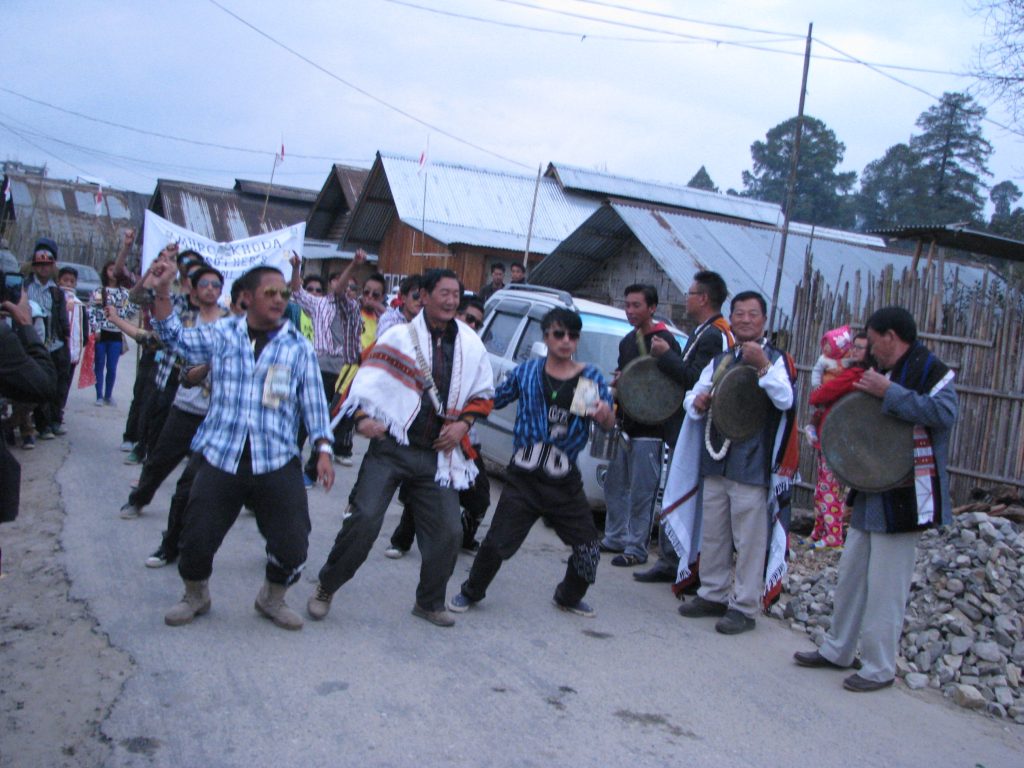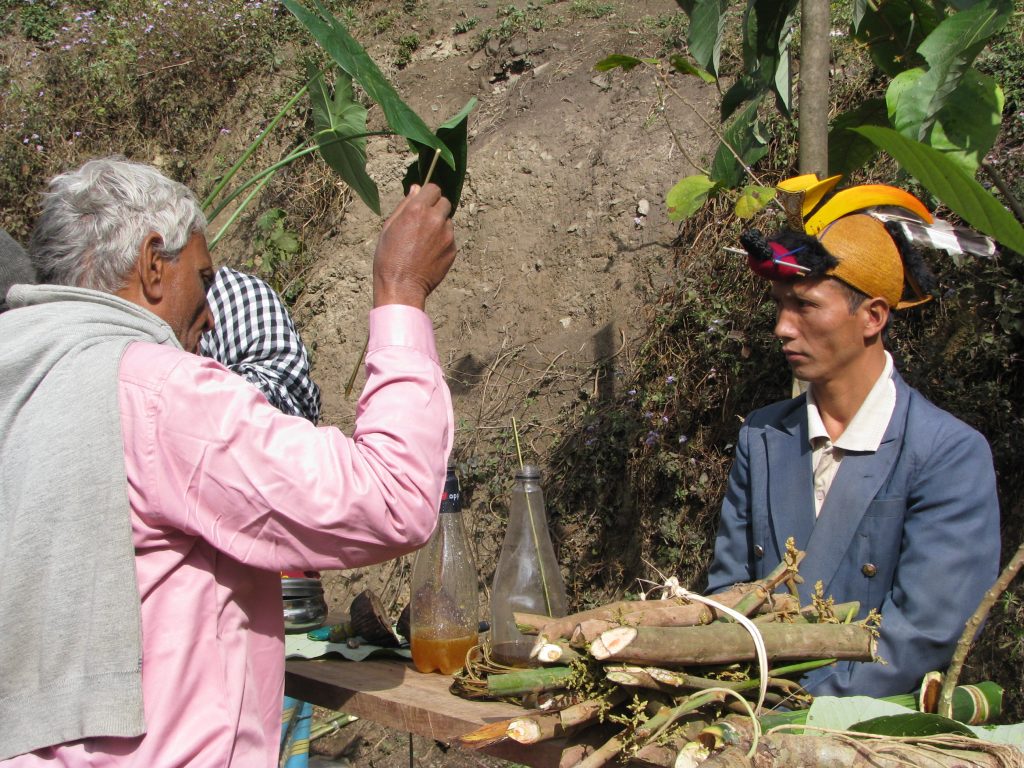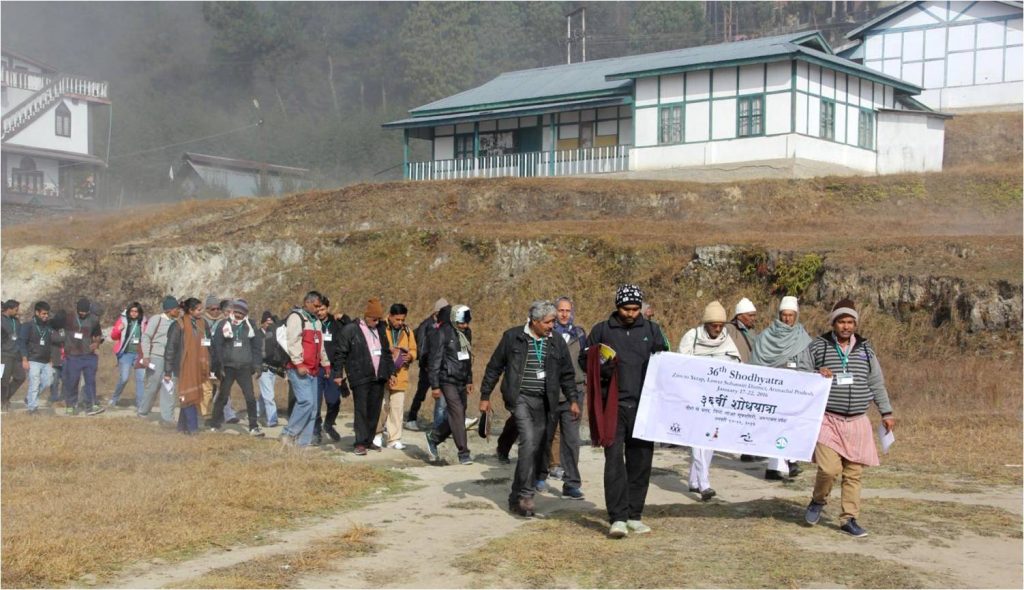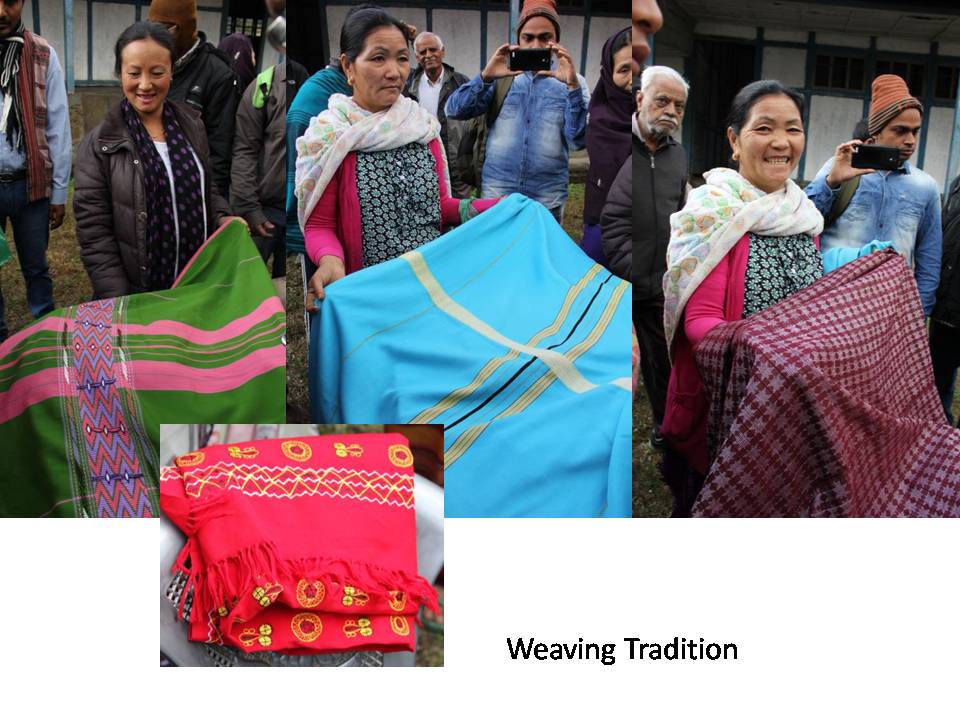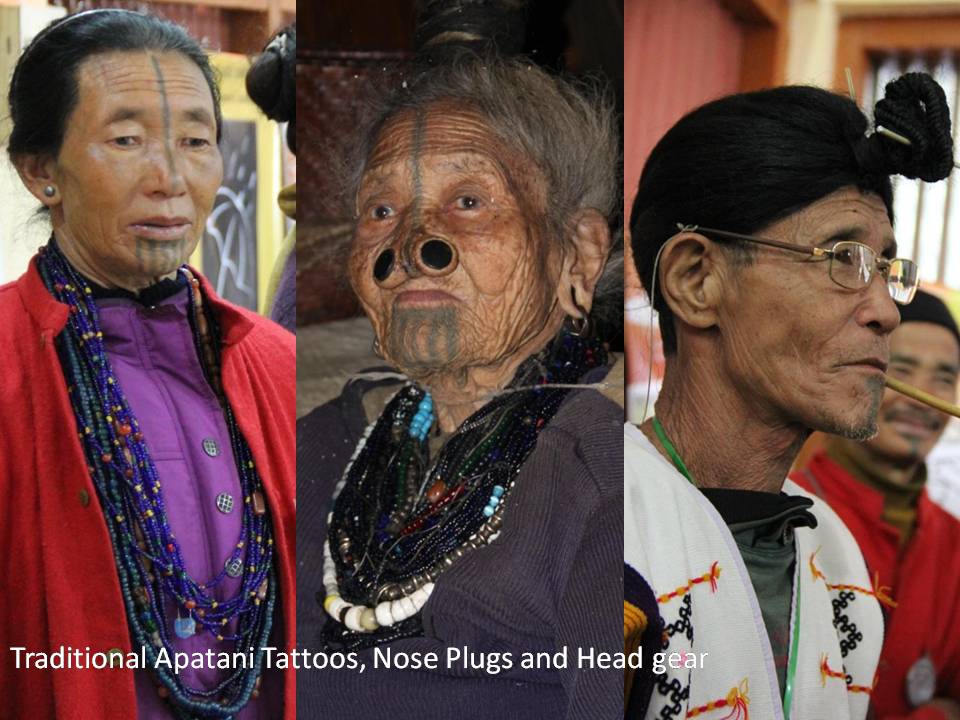Get Next Shodhyatra Update:
Phone:
079-27913293, 27912792
Email:
shodhyatra@sristi.org
36TH SHODHYATRA - ZIRO TO YETAP (ARUNACHAL PRADESH)
January 17-22, 2016
A LAND WHERE SUN RISES EARLY, AND THE SKY BENDS DOWN
The Shodhyatra in Ziro valley, Arunachal Pradesh, January 17-22, 2016, convinced us once again about the widely pervasive human desire to learn from the local as well as exotic creativity and knowledge system. Whenever we shared ideas from other places having local relevance, some or other experiment was recalled. When a idea had no local counterpart, a deep appreciation followed. Some children even offered to improve the design of a cycle hoe we had brought. Beginning from Ziro (located in the Lower Subansiri district), the learning walk ended in Yetap, covering about 100 kilometres. For a valley under consideration of World Heritage Site by UNESCO, there is a lot that can be mended, minded and of course meaningfully revitalised.
“Can we make a pen which lights up in dark,” asked Sanjay, a student of class three from Ziro Primary School. In the difficult terrain of Ziro valley, with erratic power supply, a pen that lights up reading portion is surely not a luxury. Ideas like this warmed up the walk in an otherwise very cold weather. Early in the morning, one could see a thin layer of snow on the grass. The hospitality of the people was so warm that we often got late in the night due to many unscheduled stopovers on the way. Though people had to bring firewood from a long distance, almost every night we had a fire to sit around and reflect on the day. It was a misty day, as if the sky had bent down when we started to walk.
Arunachal Pradesh, may appear remote area to some, but it is a must destination for those hungry for creative ideas of youth and children. What if while playing guitar, we also generate power.
Wouldn’t children be inspired to play longer and better? A young girl, Abo Kristi wanted art centres in every village so that those who are passionate about art, can meet other artists and be mentored by them if needed. When there is no signal in mobile phone, Hong suggested a feature which tells the user in which direction one should walk to find the signal. In a hilly terrain, this is an everyday problem. One couldn’t ask for more to be hopeful about what to come next in the shodhytra.
Apatani and Nyishi tribes inhabiting the Ziro valley warmly welcomed sixty-seven curious walkers/yatris in the valley to discover local innovations and traditional practices in vogue.
By the time yatris checked into a cosy middle school in the afternoon, the sun began setting, the yatris and the villagers gathered to learn from each other. A middle-school teacher, Rugu Kukal, narrated the history of the Apatani tribe, described its culture and the institutions. The yatris showed several videos of grassroots innovations from different parts of the country. Once these videos triggered the curiosity of community members, they were requested to suggest some new ideas and techniques.
The Apatani women enquired about a device which could make ploughing easy, given the hilly terrain of the valley. Fortunately, the Society for Research and Initiatives for Sustainable Technologies and Institutions (SRISTI) and the Honey Bee Network volunteers were carrying one such innovation. On being showed the cycle plough developed by Gopal Bhise, Maharashtra, and awarded by National Innovation Foundation, the children and women got interested and many of them took turns to try it. They also tried other products that were offered, and discussed how these devices would make their lives easier. The enthusiasm of women folk for knowing about new ideas was infectious. Nothing could have marked a meaningful onset of the six-day shodhyatra better.
One of the 26 tribes of Arunachal Pradesh, the Apatanis are known for their beauty. In fact, a story goes that the women here were so beautiful that men from the Nyishi tribe started kidnapping them to marry or for keeping them as housemaids. This led to serious tensions. To safeguard their own tribe, the women decided to make themselves look ugly by piercing their nose with black buttons and tattoos on forehead and chin. With time, this became an identifying mark for the Apatani women and these alterations actually became a mark of beauty for them.
But we appreciate that the innate beauty can never be masked or amplified by just the external marks or tattoos. It was this radiance of serenity we were learning to appreciate.
Handloom is used to weave beautiful designs by almost every household as in many other parts of north east. But the designs are quite different here. The dimensions are also bigger here, unlike in some other states.
To allow drainage of rainwater and too keep pests and animals away, most people make bamboo houses on stilts. Farm animals are kept alongside in many cases. There is a fireplace at the centre of the big room in each house. It is used for cooking and keeping the place warm. Everyone sits around the fire while eating or talking. The key cultural lesson was not lost on the yatris. The women are by design, part of every discussion in the family. Their place is the central place of the house. This is a lesson that the rest of the country has to imbibe The walls are made of flattened bamboo in a chequered fashion. They provide good insulation and ventilation at the same time. The average life of a bamboo house is approximately five to ten years. Some of the new houses coming up in the region are a fusion of bamboo and bricks, which extends their life by many years.
The knowledge of local biodiversity and its uses is very rich among communities, particularly women. Many of the plants they eat solve gastric problems, for example yabing (Cephallostachium capitatum), riikoh (Gynostemma pedata), pakhua ma and santero (Litsea cubeba). This apart, they also have mint plants used to cure cold or cough kukoliyo (Artemisia indica), yorkhun (Acmella paniculata). To control blood pressure, they eat pato hamang (Clerodendrum colebrookianum); to cure skin burning, they consume pig’s gall bladder. The cuisine showcased in every village was full of leafy vegetables, tubers, mushrooms, much of which were gathered from the forest. Only a few plants are cultivated. The rich taxonomic traditional knowledge of women can provide leads for not only nutritious food but also herbal medicine. One of the most interesting moment in the Shodhyatra was when a lady, after showcasing more than 16 varieties of paddy conserved by her, including Akne Amo, Ampu Hath Amo, Alang Amo, Punko Amo, Halya Amo Oho, Halyag Amo Ako, Neli Amo, Are Haso, Pulu Pyapic, Taba Bamii Pyapig, Tippe Pyapig, Palo Pyapig Aami, Pyatii Pyaji, Pyatii Mipya and Lanchang Mipya (red rice) asked us a very simple question, “It is not enough that you come, visit us and learn from us. You should take us for Shodhyatra in your region.” And she was right. It is our duty to have a fair reciprocity in this regard. We plan to follow it up before the next Sattvik Traditional Food Festival.
A local saying conveys their commitment to sanitation and farm management, “The home might not be clean but the farm will always be clean.” Known for their paddy-fish cultivation, the Apatanis follow several traditional practices. Paddy-fish culture requires stronger bunds. Another popular practice in paddy fields is keep them submerged in water even when there is no standing crop. This is done for three reasons. One, it makes the task of uprooting stubble easier. Two, this promotes the growth of algae which act as a natural manure and keeps the field fertile and three, it helps in weed control.
The mosaic of red and green algae in terraced paddy field was almost like landscape poetry. The yatris saw in some fields green algae while in some, red. Upon inquiry, they learnt that the alga grows green at first but upon blooming, it turns red. This is a natural indicator about the status of the fields. The farming techniques include use of vermin-wash, an organic substance collected from vermiculture pots that allows the seeds to germinate early.
The Apatanis celebrate two main festivals: Myoko and Dree. Myoko is an annual festival, held in March. One of the villages in the region organises it where neighbouring farmers gather to rejoice. The festival involves singing, dancing and merriment. Dree happens in July. The tribe offer sacrifices to the gods, seeking blessings for good rains and paddy harvest. They are known for their cultural method of wet rice cultivation. During our walk, we saw an interesting procession of different groups in one of the villages. The dancers had painted their faces and used various kinds of mask to dance. The residents were offering sweets, meat, snacks and drinks to the dancers and others passing by.
During the idea competition held at the primary school in Ziro, several ideas revolved around providing solutions to the lack of electricity in the village. One idea that stayed with the shodhyatris was of devising a pen with light on it.
A lot of kids also suggested solutions for facilitating writing and reading in the dark. A girl suggested a device that could generate electricity from a bonfire. Pooja, a student from the school, suggested that heavy bags and suitcases should come with wheels fitted to them. Though already implemented world over, the mere mention of this idea by a child here reflects how disconnected the regional consciousness of children was with the rest of the world.
Soaked in the creativity of little children of Ziro, the yatris moved towards Hija. Here, they observed that most of the houses had small artefacts, made of wood, bamboo, grass and egg shells. These were designed to perform the Tamo-Agya ritual which is supposed to ward off diseases and sickness from the family. It involves sacrificing a chicken. Many tribes in Arunachal Pradesh, especially the Apatanis, follow Donyi Polo religion, Dani meaning ‘sun’, indicator of female energy and Polo meaning ‘moon’, signifying male energy. The followers of this faith treat nature as its god. Its followers can be easily identified by a white flag, with a red sun at its centre, flying outside their homes.
Subterranean innovation Liagi Baht is an unusual innovator. He began as a vehicle mechanic and now works as a motor vehicle inspector in the local administration. He studied upto 10th class but in the ‘laboratory of life’, he must be considered much advanced. In 1999, he had innovated a very affordable solution to a pervasive local problem. Those who believe that Intellectual Property is a concern of an urban educated class, will be surprised to know that he did not share this information with anybody fearing copying of the machine. After understanding the purpose of the Honey Bee Network, he gained confidence to share it with. When we reached his farm, we saw a bamboo flattening machine which would flatten several times more bamboos than possible manually.
Local communities use flattened bamboo strips, about six to eight inches wide for weaving the mat used as walls in the huts. Normally, two to three people would hardly process about thirty bamboo strips in a day. This machine can flatten 150 bamboos. SRISTI has given him an installment of Rs. 25000 to make another piece for local field testing. An equal amount will be given after he has made progress. Social Innovation Fund of SRISTI (www.sif.sristi.org) provides help to students, teachers and other professionals whose ideas cannot be funded by NIF.
INQUISITIVE CHILDREN AND BOUNTIFUL NATURE
Exchanging knowledge and inovations with the Apatani and Nyishi communities reinforced the belief of yatris that this culturally-rich region can teach us a lot about some of the time-tested practices for farming, healthcare, animal husbandry and nature’s conservation. Akin to a honey bee which cross-pollinates flowers, taking nectar and pollens from one flower to another, we too need to collaborate cross-culturally and share local knowledge with each other in order to engage, empathise and evolve.
Dora James and Tanya Taring, two Standard VI children, did not take too long to answer when questions about unmet local social needs were posed. Farmer innovators, school teachers, professionals, engineers, students, professors, etc., had been debating about several problems that were noticed in Tajing village, as part of the 36th shodhyatra in lower Subansari district, Arunachal Pradesh. Both Dora and Tanya surprised us with their empathy, social sensitivity and enormous capacity to handle various technological challenges. We had seen people dragging bamboo to their homes for processing on their shoulders, after harvesting it from their farm. Shodhyatris had discussed the previous night about different ways of reducing drudgery in this task. These kids didn’t take a minute to suggest a solution of making a simple wheel stand to support bamboo on one side and reduce drag load. Having been encouraged from their curiosity and samvedansheelta, we asked them to point out more areas where innovation was needed. They quickly pointed out the need for a low-cost plough that can help them till small undulating plots of cardamom, upland paddy and ginger. We showed them a cycle-wheel plough. They immediately started pointing out various improvements in this plough to suit their conditions. “Can there be two wheels? Can harrow be replaced with a spade? Can there be a break for its use on slopes?” Children have ideas but they need immediate support. Unless we develop an agile, responsive and impatient system for supporting innovations at grassroots, much of our promises to young people will remain a mere promise. Gopalbhai Bhise’s cycle-weeder found a new incarnation in Arunachal Pradesh.
Khoda Yam and Tanya Yaming, two girls of Standard VII, found that manual dibbler for sowing seeds of paddy and other crops, designed by Manuskhnhai Jagani, needed to be lighter, more adaptable and flexible for local needs.
Our engineers at SRISTI had not thought about several limitations that these two girls pointed out. Yet national innovation policy is not posing enough faith in the potential of young children. It is not just two innovations per school but may be dozens that may need support.
In Hija, the yatris met two local innovators. Nada Taki, a local craftsman, has created a whole range of tools and utensils from bamboo, like spoons, forks and mugs. He has also crafted a thermos. A little less than a feet in diameter, this one-piece thermos is not for sale though. It is only to be used by the family during festivals of Dree and Myoko. He showcased a range of swords, knives, bow and arrows, and arrow guns. Some were made by him while others were collected over the years, to keep the Apatani culture alive. Not just a craftsman, Taki culture alive. Taki is one of the first grassroots innovator to be identified by the shodhyatris in Arunachal Pradesh. He used motorcycle parts to weld a stable dinner table for his family. He also made a three-wheeler from scrap motorcycle parts. Even with bleak resources, Taki has set a perfect example of creativity in adversity.
Another innovator, Dani Nana, is known in Hija for innovations in the agricultural field. He has designed a number of farm equipments to support agricultural activities in the area. Located in the hilly terrain, farming in Arunachal Pradesh does not involve any tractors or animals. Almost all work is manual, keeping which in mind, Nana designed small, precise tools to ease farming and ensure perfect cultivation.
During the idea competition in the Hija village school, the children came up with innovative solutions to problems faced by their community. Here people are passionate about music. A kid thought of a solution which could include this zest for music and provide creative solutions for the electricity crisis. The child suggested that we could generate electricity by the strumming of guitar and this, he said, would also inspire the artists to play longer and better. Another student, Abo Kristi, suggested that art centres should be opened in villages which would train people who are passionate about pursuing various courses but do not know where to get guidance from. Dutta, a student of Shri Gegong Primary School, suggested that a siren should be fitted on bikes that goes off during accidents. He also suggested a solar wall clock which could be lit during night with the solar energy stored during the day.
In Siro, they met Hibu Taku, a wood craftsman. Taku displayed some of his exquisite wood work in the school. Upon entering his compound, one could smell the freshly-cut wood. Although most houses in Ziro were made of wood (or bamboo) or fusion (bamboo and bricks), Taku’s house was wood insideout. There was almost no metal, except for his own tools and few utensils. The chairs, the ladder, spoons and plates were all made of bamboo or wood. For the handicrafts, he had a separate wooden house. Some of his amazing work includes a climber in the shape of a dragon and a mushroom in the shape of a butterfly. A man can go far with his hard work and dedication but further, with a companion. Taku said his passion would have remain hidden, had it not been for the support of his wife and kid.
Moving further in the valley, the yatris came across a bunch of workers who were crushing stones, five to six inches in diameter, to smaller stones. They used a hammer and held the stone in its place with their hands. But, they kept their fingers safe from the impact of the hammer by wearing a small piece of car tyre (in their first finger and the thumb). This was a simple idea but at the same time, a useful one. Narang Tling, a student of Standard VIII, used sang mya, white wood, to make beautiful flowers. Hibu Abing used chenu enji, a unique straw found in the forest, to make roofs of huts. The next halt was at Hari Basti. During an idea competition at the Senior Secondary School here, two students came up with progressive solutions to real-life problems. One, when there is no signal in phone, it should be able to guide the user to move in the right direction in order to get the nearest signal. In hilly areas, it could be a beneficial feature. Another idea was to make a hairband which could relieve people of headache.
The communities preserve wild apples and ginger in two forms–sweet (candies) and sour. The Apatanis do farming of green, leafy vegetables in the higher areas while the lower areas are used for cultivation of paddy. Pear is prominent while apple farming is subsiding gradually, owing to change in climatic conditions. The food of Apatanis is mostly boiled and salad comprises leafy vegetables. People do not eat much spices and the use of oil in cooking is restricted to minimum. Simple food, organic farming and an active lifestyle keeps people fit and healthy.
In Hari Basti, the shodhyatris also met Hage Tado Nanya, a pisciculture specialist, who developed the paddyfish cultivation in 1976. She has, over the years, made several instruments for the purpose. She has made special baskets to catch fishes, bushes to act as homes for caught fishes, where they can lay eggs, and some leaves that could make them unconscious, so they can be caught easily. The veteran farmer has also discovered and documented 15 varieties of rice: Akne Amo, Ampu Hath Amo, Alang Amo, Punko Amo, Halya Amo Oho, Halyag Amo Ako, Neli Amo, Are Haso, Pulu Pyapic, Taba Bamii Pyapig, Tippe Pyapig, Palo Pyapig Aami, Pyatii Pyaji, Pyatii Mipya and Lanchang Mipya ( r e d rice). While the shodhyatr i s were getting ready to embark towards their next destination, Nanya remarked that it was the yatris’ responsibility to spread the knowledge acquired in their journey to other parts of the world.
After imbibing the knowledge shared by the Apatanis, the yatris left for Tajang. Here, they met the members of Nyishi, the largest tribe in Arunachal Pradesh. They live mostly in the heavilyforested areas, and are best known for Jhum cultivation (shifting agriculture). The Apatanis and the Nyishis share a natural boundary between their areas and everybody adheres to it. This is a living example of mutual respect and cooperation.
In Tajang, they met Taje Tejung, a centenarian. Tejang shared that in the olden times, they used to hunt small rats and birds from the jungle to eat. Though, he was married and had six kids (three girls and three boys), all had died, and he lived alone in his traditional house. Although alone, he got a lot of help from the community. Listening to his story raked up some emotions within the yatris. They saluted the community which takes care of its elders.
Pussang, an innovator, had studied till Standard IX. He has made a modified coupling-based rice-heller. Pussang already has six orders for the machine which costs only ₹2,500.
While walking towards Limpia from Tajang, the yatris observed wild kiwis along the way. The forest was dense. Sometimes, a tributary would flow along the path. Our walk through the region was accompanied by continuous drizzle. The Nyishis are peace-loving. Their faces reflect contentment and happiness. They wear a traditional hat made of bamboo. Traditionally dependent on forest, the people have different tastes in food if compared with the Apatanis. The vegetables were made from bamboo and other leaves. A chutney was made from chilly, salt, meat-oil, ginger and local leaves. Principal crops in this region include paddy, tapio (maize), mekung (cucumber), takie (ginger), aange (yams) and temi (millet). Rice, like the Apatanis, is the staple food, supplemented by fish, meat of various animals, edible tubers and leafy vegetables. The Nyishis also include fruits, roots, bamboo shoots, wild animals, fishes and wild leafy vegetables in diet. The traditional ways of preparing them include steaming, roasting and smoking.
Before the modern economic system came in practice, barter system was prevalent in this region. The Nyishis valued the generalised reciprocity and even now, try to balance the same. The Nyishi tribe is also known in the region for their aversion to allopathy. The nearest hospital from the village was at a distance of 12 km, so delivery of babies mostly happens at home. This also explains why the most villagers rely on tribal medicinal practises.
Upon enquiring, a woman from the village (10 km inside the jungle) shared her child’s educational road map. Her child would have primary education in the village and will then move to a high school in the Ziro valley (the pass percentage in Ziro is 100 percent). Though the Nyishis have sufficient resources to meets their needs, they are economically weaker than the Apatanis. Among the festivals celebrated in the region, Nyokum is the most popular one with the Nyishis. It happens every year in March, in memory of their ancestors. The Nyishi women are strong and practice archery. The Nyishi villages nominate an elderly from each village (gaambudha) who acts as a mediator between villages in case of conflicts. This person is required to wear a red coat and is revered by all.
The next halt was at Loth, spread beside the Ping Paubriver, gave yatris a chance to meet Harung Tabung. Looking at Tabung, one would guess his age but, never could one reach the correct number. An energetic old man of 107 years, he shared that he has never eaten lentils (dal) or had masala (spices). All he has had is leaves, fruits and rice. Living in a hilly area, he has done a lot of physical exercise, the secret behind his fitness.
The tribes in Arunachal Pradesh follow semi-domestication of mithoons. They don’t milk them. They leave them to live in the wild. Even when the animal is pregnant, it remains in the forest. Each mithoon has a mark of their owner. This helps the owner in bringing them back from the forest whenever needed. Sometimes, the mithoons also find their ways to the owner’s place. The yatris observed that garbage was a big problem in this region. Plastic bottles and wrappers were littered everywhere. The yatris were told that during the Murung festival, performed by childless couples and people seeking peace at home, people throw plastic glasses all over the place.
Over the week, the yatris also observed that the Apatanis do not follow Jhum cultivation, followed by the Nyishis. They are rice and fish cultivators. Cutting forest is looked down at in their tribe. Land management is much better among the Apatanis. Even though there are no major rivers, the community has built small streams to water their fields. There is almost no malnutrition among kids. The possible reasons may be because children are breastfed for a longer duration of time (four to five years) and the people consume healthy organic food.
The yatris observed that fields were of random and uneven shapes here. The reason being, when a land is divided, each person of the family gets equal parts of both the fertile and infertile lands. Despite the chilly conditions of the valley, the Nyishis use wood very frugally. Their vision and far-sightedness teaches us many lessons about sustainable use of resources.
FLICKR GALLERY
